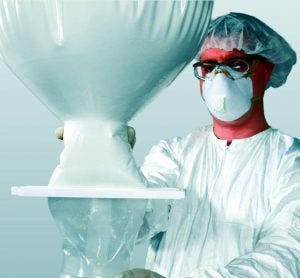- Business
- Sponsored Content
Ask the Expert for Better Single-Use Powder Containment for Media and Buffers
Sponsored Content
Dave Howes (senior applications specialist at ILC Dover) introduces his company’s market-leading solution for single-use powder containment.
Howes’s Presentation
Some challenges in biopharmaceutical powder manufacturing include optimizing open-suite facilities; minimizing product loss from spills; lessening waste and cross-contamination; reducing worker exposure to airborne particulates; and lowering the risk of ignition with flammable materials.
 Characteristics to look for in a powder-transfer system are
Characteristics to look for in a powder-transfer system are
a system design that is exclusively meant for powders (not adapted from liquid-transfer designs)
large-diameter top openings for easy filling and fine-tuning of final fill weight
suitability for a broad range of filling and dispensing volumes, flow rates, and product weights
rugged, disposable single-use transfer bags with antistatic properties
the ability to provide for fast, clean discharge into process vessels.
The EZ BioPac system provides an answer to meeting the challenges above with all needed characteristics. It is designed specifically for powder transfer and containment by ILC Dover experts in this field. The design addresses the issues highlighted above and offers distinct advantages over systems that have been derived from liquid-handling technology. The EZ BioPac product range covers 1–100 L, with flange sizes of 1.5–8.0 inches.
Filling and Discharging: An EZ BioPac system offers multiple advantages to bioprocessors, especially compared with bags derived from liquid-based systems. The first advantage is its large fill opening. Bags derived from liquid-based systems typically open on one end only, and that opening tends to be small, inconveniently requiring additional equipment such as a funnel when used with powders. EZ BioPac bags are designed with a single large opening on the top that is separate from the single discharge opening on the bottom. That allows for fast, consistent filling and fine-tuning of powder weight while reducing the chances of overflow, spillage, and surface contamination. The outlet design can be provided in a user’s required form.
Unlike in “two-dimensional” (2D) bag designs — in which inlet and outlet are combined into a single opening — the EZ BioPac bag outlet is dedicated and can be designed to meet individual customer needs. ILC Dover has proven its filling performance with an analysis comparing a 2D bag with the EZ BioPac system: The latter achieved a 71% faster total fill time and >18% faster total discharge time, with a third less powder retention in the bag.
Contamination Control: The next advantage is contamination prevention. EZ BioPac bags have an outer skirt that folds down completely to cover the system frame and the outside of the bag. After filling a bag and adjusting its weight, users can turn the skirt back up into its normal position. Any powder that may attach to the outside of the skirt thus becomes part of the bag’s interior surface, greatly reducing the need for subsequent cleaning.
Sample Sealing and Support: Another advantage is the choice of two simple sealing options. The standard proprietary DoverPac crimping system has been proven across thousands of installations and uses. Alternatively, users can make a simple “Z” fold by hand within the neck of the bag, then clamp it shut with attached cable ties.
A self-supporting frame pairs with the bag and allows it to be fully opened and supported on a scale. The weight of the frame is insignificant. It stands secure and open, allowing users to fill a bag and adjust the weight as needed, while eliminating the need for unwieldy barrels and other containers. The skirt is designed to slide down the outside of this frame during filling, which eliminates the need for additional cleaning.
Disposable EZ BioPac single-use bags are made of ArmorFlex 114 film. It has permanent antistatic dissipative properties that prevent powdered materials from clinging to the inside of a bag when dispensing. That maximizes the amount of product that can be discharged and minimizes the amount of material left within a bag. ArmorFlex film has a five-year shelf life and meets US Food and Drug Administration (FDA) requirements for good manufacturing practices (GMP) certifications.
Questions and Answers
The company welcomes all questions any time at www.ILCDover.com.
More Online
Watch the full presentation of this webcast (with slides and audio) now.
You May Also Like





